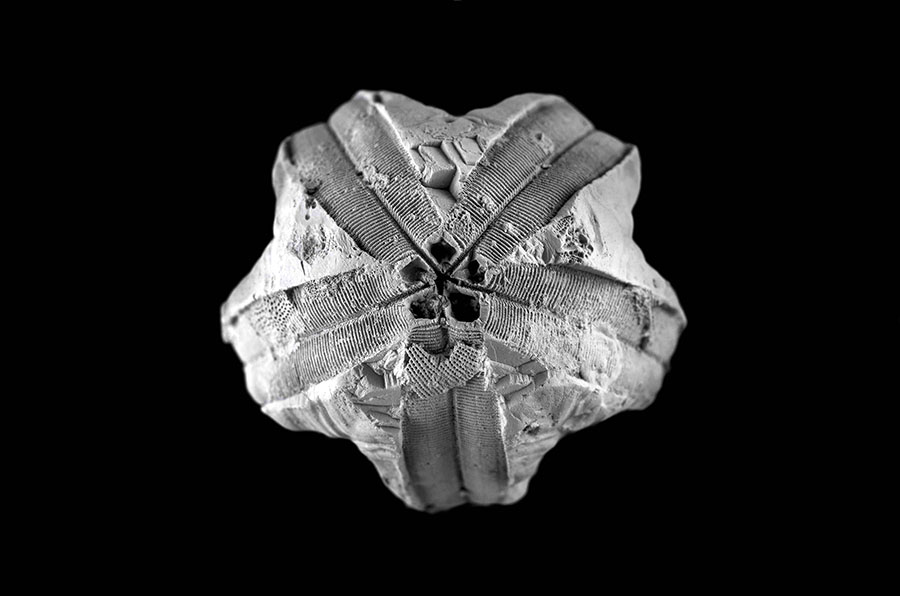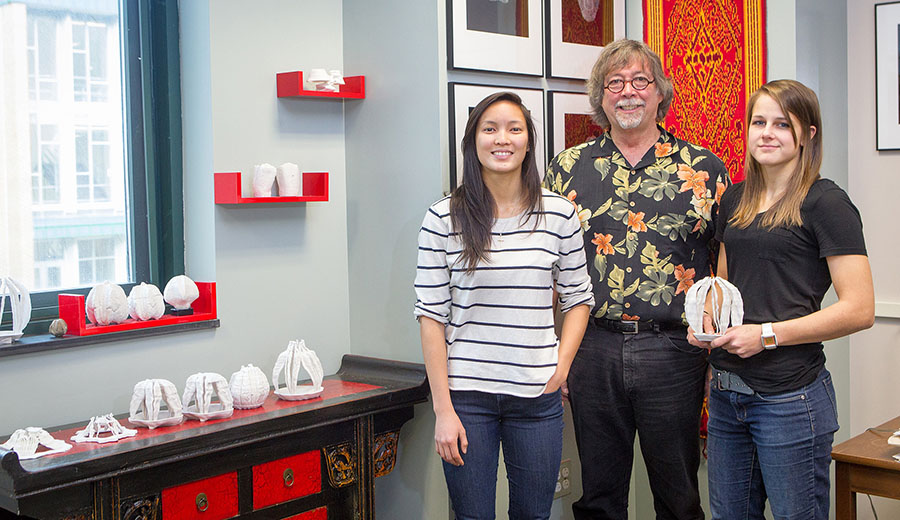
Dr. Johnny Waters, center, from Appalachian State University’s Department of Geology, is working with former student Bonnie Nguyen, left, and senior Lyndsie White to better understand blastoids. Through the use of technology, Nguyen and White have created 3-D models of the ancient marine animal, as well as computer simulations showing how water flowed through the animal’s gill-like structures. White is holding a 3-D model of the marine animal with more models shown to the left. (Photo by Marie Freeman)
BOONE—Lyndsie White is a senior industrial design major at Appalachian State University. Bonnie Nguyen is a recent graduate of the university’s exercise science program.
They might seem like an unlikely pair to be part of a research project based in the Appalachian’s Department of Geology, but their skill set is helping Dr. Johnny Waters and others better understand blastoids, an ancient marine group of echinoderms and distant cousins to starfish and brittle stars.
Their work is part of the National Science Foundation-funded Assembling the Echinoderm Tree of Life (AEToL) project being conducted by more than 25 researchers across the U.S. and the U.S. territory Guam.
While part of the research team is studying living echinoderms, such as starfish, brittle stars, sea urchins, sea cucumbers and sea lilies, Waters, White and Nguyen are part of a larger research team studying fossil echinoderms including blastoids.
“They have been extinct for 250 million years. We are reconstructing them as animals,” Waters said of the fossils.
White and Nguyen joined the research project nearly two years ago after responding to an ad Waters posted in the student newspaper seeking student assistants. Both have published and presented their work with Waters at national conferences.
Their computer skills have become an invaluable contribution to his work. “This project would have never gotten off the ground without these students,” Waters said.
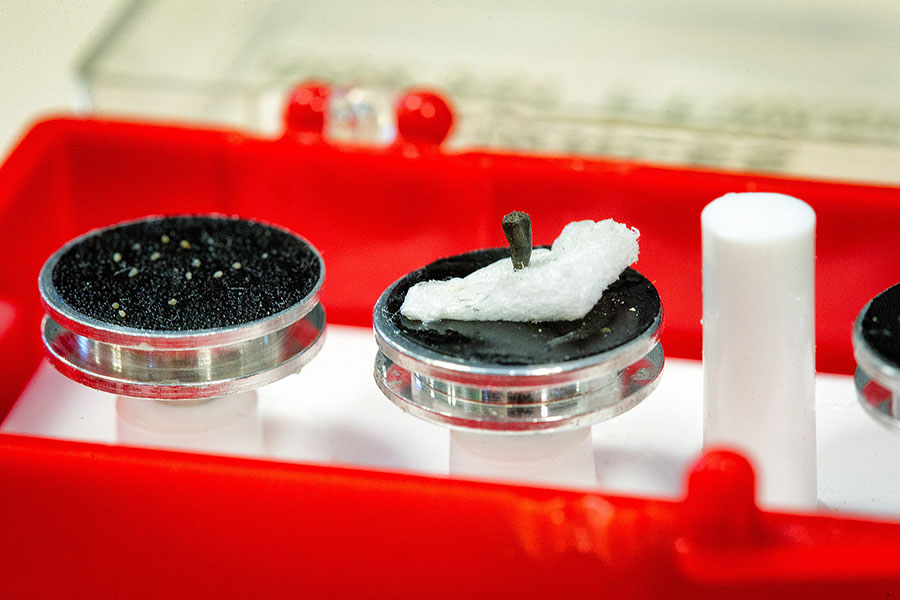
MRI-like images taken of this tiny blastoid (center) allow Dr. Johnny Waters and his research team to see the interior of the marine animal without destroying the fossil, which is no larger than the end of a toothpick. It is shown larger than scale in this magnified image. Waters collected the fossil in China. (Photo by Marie Freeman)
Waters and his students have focused their work on better understanding the blastoids’ internal anatomy.
White uses her graphic imaging skills to create replicas of the marine animal using a 3-D printer in Appalachian’s Industrial Design program, based in the Department of Technology and Environmental Design. The replicas are based on acetate peels created in the Netherlands in the 1960s when blastoid fossils were literally ground away to create thin acetate images of their interior.
In addition, data from present-day technology have allowed Waters and Nguyen to create 2,000 MRI-like layered cross sections of the interior structure of other blastoid fossils. Waters traveled to Zurich, Switzerland, last spring to create the scans using a synchrotron, which provides “a high-energy source that lets us see the interior of the fossil without destroying it,” Waters explained. Nguyen taught herself how to use the software used to create the 3-D reconstructions.
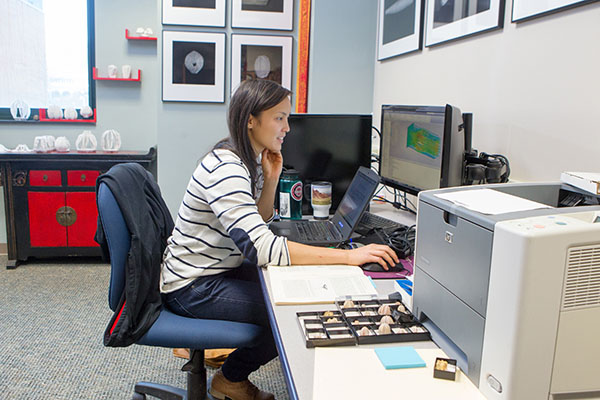
Bonnie Nguyen, a recent graduate of Appalachian State University’s exercise science program, is part of an interdisciplinary research team working to better understand blastoids, an ancient cousin of starfish and brittle stars. The work is part of the National Science Foundation funded Echinoderm Tree of Life project. Nguyen is simulating water flow around the blastoid to better understand how it lived in a marine environment. (Photo by Marie Freeman)
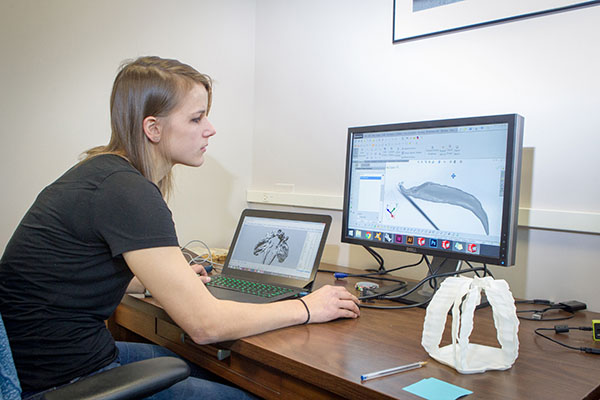
Lyndsie White, a senior industrial design major at Appalachian State University, processed images of a blastoid to create a 3D model of the marine animal’s interior, shown in the foreground. She currently is creating flow simulations of how water passed through the blastoid’s gill-like structure to better understand its internal anatomy. (Photo by Marie Freeman)
The ability to “see” the blastoid’s interior, including its gut, is even more impressive considering the fossil Waters and Nguyen imaged is smaller than the end of a toothpick.
According to the Scripps Institute of Oceanography, “Echinoderms … provide a crucial link to understanding the tree of life as a whole and the history of our species.”
Echinoderms and all vertebrates (animals with backbones) share a common ancestor from the geologic past, Waters explained. “We are trying to understand how blastoids are related to other primitive echinoderms that lived at the same time, and are expanding the data set of external characters of blastoids by looking at their internal structures.”
The blastoid physical models and scanned images enable White and Nguyen to use graphic design and animation software to develop computer simulations of how water flowed through the marine animal’s hydrospires or gill-like structures that act like a gas-exchange system. They will travel to Spain in June to present their latest results.
“This is the first time anyone has visualized these soft-tissue systems,” Waters said. “Most of the time imaging techniques, including synchrotron imaging, don’t actually work on these fossils, so we are very excited when we actually get good results.”
About Appalachian State University
As a premier public institution, Appalachian State University prepares students to lead purposeful lives. App State is one of 17 campuses in the University of North Carolina System, with a national reputation for innovative teaching and opening access to a high-quality, cost-effective education. The university enrolls more than 21,000 students, has a low student-to-faculty ratio and offers more than 150 undergraduate and 80 graduate majors at its Boone and Hickory campuses and through App State Online. Learn more at https://www.appstate.edu.
What do you think?
Share your feedback on this story.
